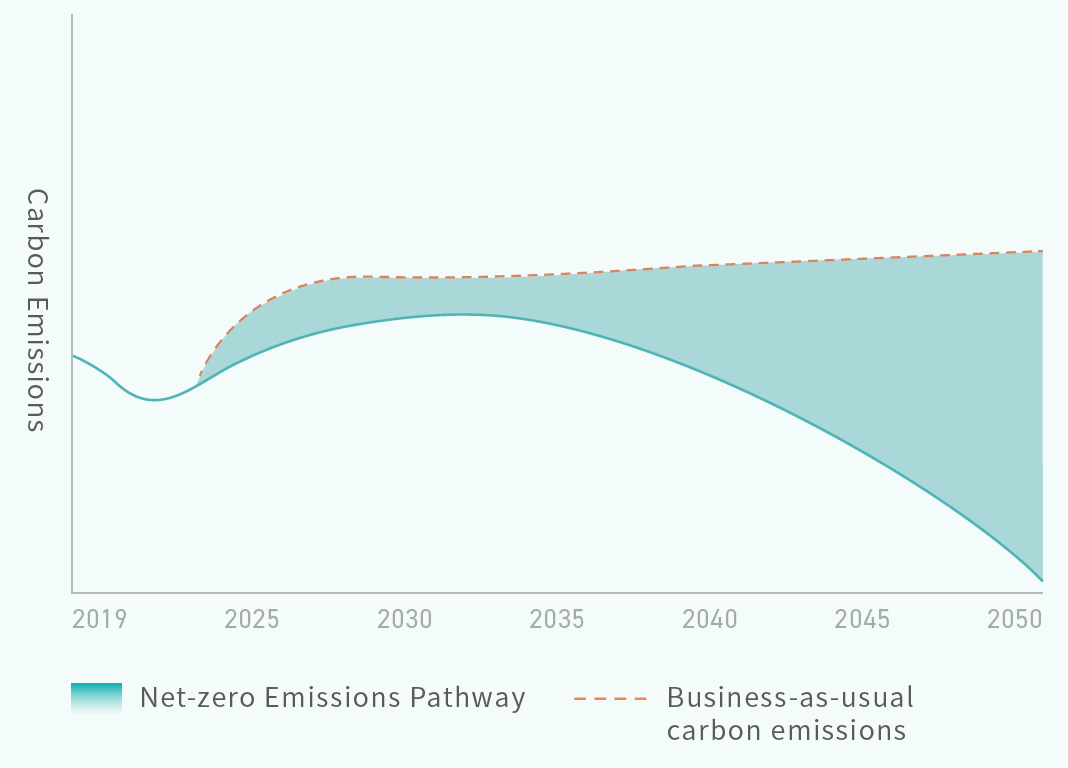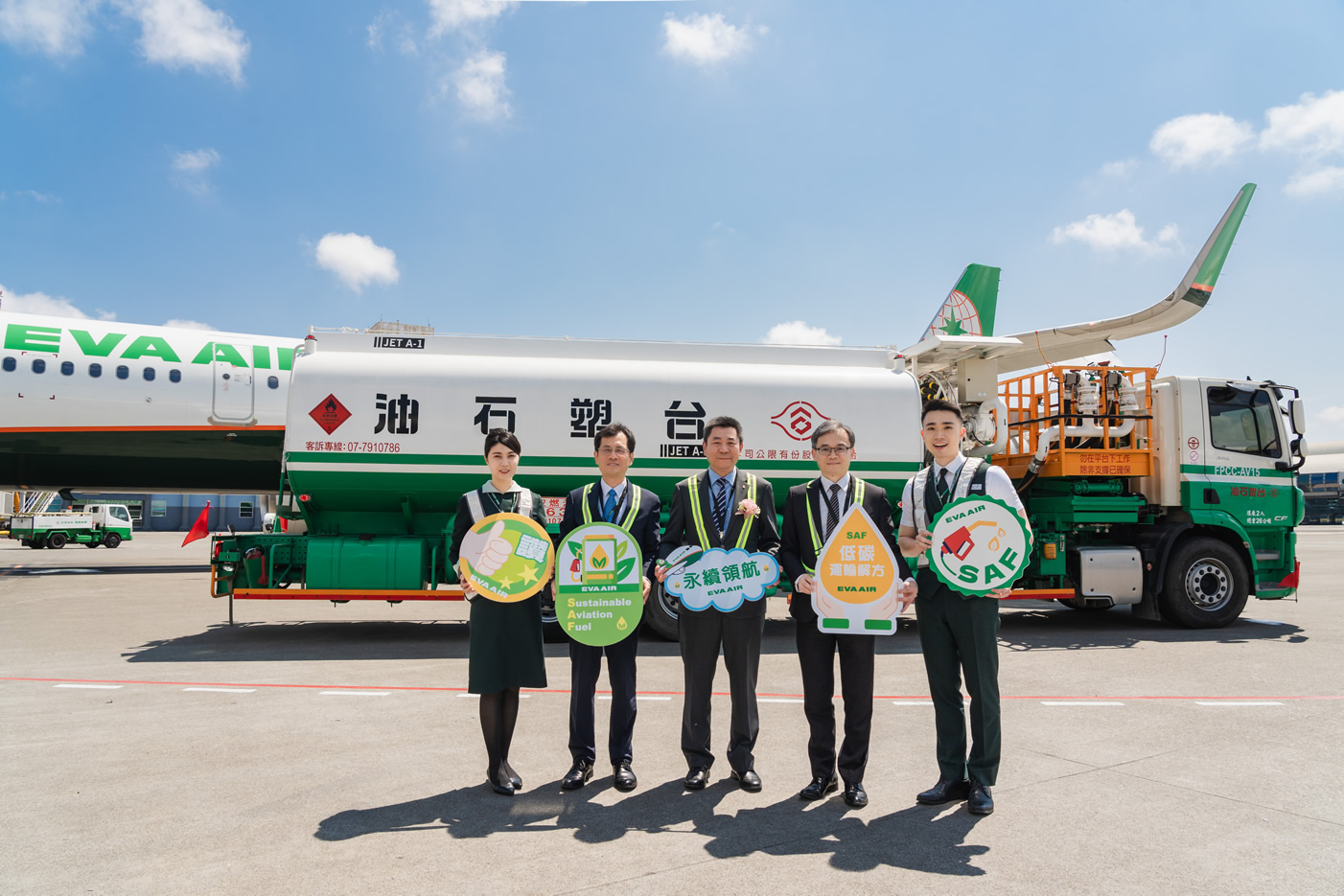EVA Air's Blueprint for Net Zero Emissions
In 2021, the IATA declared the Net-Zero Emissions by 2050 target, which aims to limit global warming to no more than 1.5°C. In response to this, in November 2021, EVA Air declared our commitment to achieve the goal of Net-Zero Emissions by 2050, eliminating at least 90% of our carbon emissions under Scopes 1 and 2 while implementing a carbon offset program for other carbon emissions. Our strategies include many initiatives: Aircraft and Engine Technology Development; Aviation Operations and Infrastructure Enhancement; Sustainable Aviation Fuel (SAF); Renewable Energy (Green Energy); and Carbon Offsets and Carbon Emission Trading.
To align our carbon reduction goals with the path to Net-Zero, EVA Air signed onto the Science Based Targets initiative (SBTi) in June 2022, setting our near-term targets in accordance with the SBTi’s Aviation sector guidance. In July 2024, our target of reducing well-to-wake scope 1 and 3 jet fuel GHG emissions 40% per revenue tonne kilometer (RTK) by 2031 from 2019 was formally approved, based on a 2019 baseline intensity of approximately 968 grams of CO2e per RTK. Looking ahead, EVA Air will continue to track carbon reduction results to guarantee goal achievement.
Blueprint for Carbon Reduction
Carbon Reduction Strategy
| Strategy |
Actions |
| Aircraft and Engine Technology Development |
- Continuing to introduce a new generation of aircraft.
|
| Aviation Operations and Infrastructure Enhancement
|
- Implementing aviation fuel-saving measures for aircraft.
- Coordinating with competent authorities to improve efficiency and quality of aviation management and airport operations.
|
| Sustainable Aviation Fuel (SAF) |
- Using SAF; setting quantified short- , medium-, and long-term targets on SAF usage.
- Cooperating with government, airline associations, other airlines, and fuel suppliers to build SAF production capacity in Taiwan.
- Collaborating with academic institutions and investing relevant resources to conduct feedstock research and technological innovation.
|
| Renewable Energy |
- Using green energy; set short- , medium- and long-term targets.
|
| Carbon Offsets and Carbon Emission Trading |
- Participating in the Carbon Offsetting and Reduction Scheme for International Aviation (CORSIA) and the Emission Trading Systems (ETSs).
- Launching EVA Air’s Green Travel passenger carbon offset program.
|
In the meantime, using sustainable aviation fuels (SAF) will be a major key to reducing aviation industry emissions. SAFs can reduce total life-cycle emissions by 80% as compared to traditional fuels. Starting from April 2024, daily flights from Paris, France to Taoyuan, Taiwan, as well as one demo flight on December 16 from Incheon, South Korea to Taoyuan, Taiwan, utilized Sustainable Aviation Fuel (SAF). A grand total of 76,136 USG (approximately 288,207 liters) of SAF was consumed throughout the year, accounting for about 0.01% of the total aviation fuel usage, marking a record high to date. We aim to continue providing safe flights and outstanding service, while also using enhanced fuel efficiency and lower-carbon transport to do our part in slowing down global warming.
Organizational Structure of Environmental Governance
EVA Air’s Sustainability Committee, established under the Board of Directors, serves as the highest governing body for nature and climate-related risks. The committee’s members are the Company’s directors, and the Chairman of the Board serves as the convener, with the Corporate Sustainability Committee serving as the executive committee. The Sustainability Committee has further formed an Environmental Action Team (the Environmental Committee), to take charge of assessing nature/climate-related risks and opportunities, and coordinating formulation and implementation of the Company’s policy, management, and action plans on nature-related, environmental and energy issues. The Environmental Committee is divided into three task forces for different duties: Sustainable Aviation Fuel; Environment and Energy; and Carbon Credit. These task forces’ permanent members are the department/division heads. The Corporate Sustainability Committee convenes each quarter to evaluate performance in nature and climate-related issues, thus ensuring the effectiveness of the Company’s management and policies. Progress on action plans is also annually reported to the Board of Directors and the Sustainability Committee, to mitigate climate change and negative impacts on nature. Through our management systems, EVA Air has maintained an excellent record: Zero violations of environmental laws or regulations for the past five years.
Environment and Energy Management System

EVA Air has implemented the ISO 14001 Environmental Management Systems and ISO 50001 Energy Management Systems, and established a dedicated task force (Environmental Committee) composed of specialized personnel responsible for conducting energy audits, waste audits, and water use assessments across various energy types, water resources, and waste streams. Based on our global employee coverage, 87.1% of EVA Air staff have achieved third-party external verification for ISO 14001 compliance, while the remaining 12.9% have completed internal environmental risk assessments. Through the P-D-C-A (Plan-Do-Check-Act) management cycle, we identify opportunities to enhance energy performance, water use efficiency, and waste treatment effectiveness. Accordingly, we establish quantifiable targets for energy conservation, waste reduction, and water resource savings. Environmental performance indicators are linked to senior management’s compensation metrics to ensure the successful execution of environmental initiatives, thereby minimizing operational environmental impacts.
In addition, EVA Air invests in research and development, introducing innovative technologies and environmentally friendly service products to further reduce energy consumption, water usage, and waste generation. To foster a culture of environmental responsibility, we continuously provide environmental and energy management training to all employees, enhancing their awareness of energy conservation, water management, and waste reduction, as well as the environmental impacts associated with their roles. Moreover, we have established an environmental feedback mailbox (environment@evaair.com) to serve as a communication channel for complaints and suggestions from local communities, as well as internal and external stakeholders. To date, no complaints concerning environmental impacts have been reported.
International
Standard |
ISO 14001
Environment Management System |
ISO 50001
Energy Management System |
ISO 14064-1
Greenhouse gases inventory standards |
| Key Events |
Introduced ISO 14001:2015 since 2016
Completed ISO 14001:2015 recertification in 2018
Completed ISO 14001:2015 recertification in 2021
Completed ISO 14001:2015 recertification in 2024
|
Introduced ISO 50001:2011 since 2015
Completed ISO 50001:2011 recertification in 2018
Completed ISO 50001:2018 certification in 2020
Completed ISO 50001:2018 recertification in 2021
Completed ISO 50001:2018 recertification in 2024
|
Carried out GHG inventory in accordance with ISO 14064-1:2006 standard since 2016
Carried out GHG inventory in accordance with ISO 14064-1:2018 standard since 2021 |
| Certificate/ Statement |
 |
 |
 |
Nature Recovery and Biodiversity Project

Key Biodiversity Areas (KBAs) were evaluated within 15 kilometers of EVA Air’s and our key suppliers’ primary domestic/overseas operating sites. The results showed that none of the aforementioned sites directly overlapped with KBAs, but there were KBAs within 15 kilometers of most sites. Cross-referencing our Taiwan operating sites against areas of concern on the Taiwan Ecological Network Blue Print shows that the airport and our headquarters are close to the largest national coastal wetland in Northern Taiwan, the Xucuogang Wetlands, and that airport operations may impact the wetlands. The wetlands are home to more than 200 species of water birds, with the Chinese egret (Egretta eulophotes) – a rare and vulnerable species (VU) with less than 4,000 individuals left worldwide – passing through the wetland every spring and fall. Past observations have also recorded black-faced spoonbills (Platalea minor). The wetland has been recognized as an important wild bird habitat by BirdLife International.
In 2024, EVA Air organized an internal seminar focused on the biodiversity of the Xucuogang Wetlands, aiming to raise awareness among employees about the importance of ecological conservation. Moving forward, EVA Air will evaluate ways to integrate biodiversity considerations with its zero-deforestation commitment, through the hierarchy of ‘avoid, minimize, restore, then offset’, we can mitigate our operations’ impacts on the Xucuogang Wetlands. We are also conducting a comprehensive review to determine the adverse impacts of the Company’s operations on other threatened species. Other measures to be taken include providing trainings on illegal wildlife trafficking prevention for employees stationed at locations where such trafficking is possible, and refusing in-flight meal ingredients whose source species are on the International Union for Conservation of Nature (IUCN)’s Red List.



